‘Red tide' is a costly blight that endangers health, imperils livelihoods, and knows no international boundaries. It appears when certain plankton proliferate abnormally and turn the sea bright red and it occurs in many areas of Japan almost every year. In 2016, across the Pacific, a record outbreak of red tide caused serious damage to fisheries in Chile. In response, Japanese and Chilean researchers began cooperating on projects aimed at finding ways to predict red tide at an early stage.
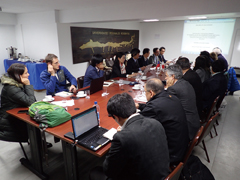
Many stakeholders from Japan and Chile gathered to discuss the aims and procedures of the project.
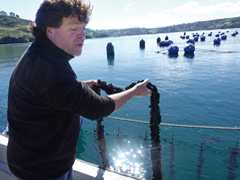
Shellfish farms on Chiloe Island, Chile. Bivalves can be seen hanging thickly on the ropes.
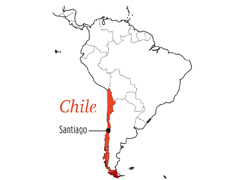
PROTECTING THE FISHERIES THREATENED BY RED TIDE:
A NEW APPROACH
Chile has a thriving fisheries industry along its extensive north-south coastline. Salmon exported from Chile is commonly seen in supermarkets throughout Japan. The widespread red tide in 2016 caused the suffocation death of some 23 million salmon in fish farms in Chile, resulting in a loss of about one billion U.S. dollars.
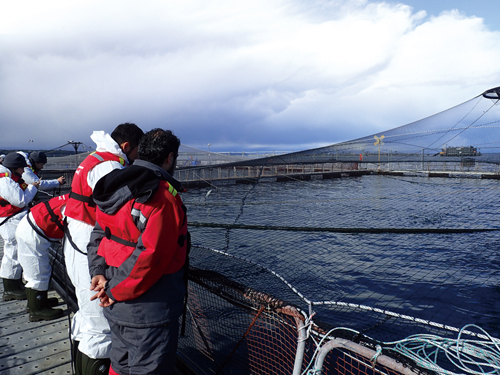
The Japanese project team visited salmon farms for a field survey in August and September of 2017.
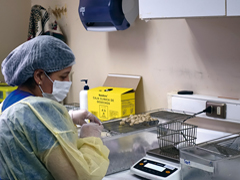
Staff inspecting shellfish at the Ministry of Health Inspection Institute. Equipment provided earlier by Japan through its JICA technical cooperation projects is also in use here.
The main cause of red tide is the abnormal proliferation of phytoplankton, which leads to the discoloration of the sea, rivers, and lakes. Researchers think that one of the causes of the plankton proliferation is the outflow of domestic and/or factory wastewater into the sea, which increases the level of nutrients such as phosphorus and nitrogen in seawater. However, the full details of this mechanism are not yet known.
Japanese universities and research institutes at Kyoto University, Okayama University, and Japan's National Research Institute of Fisheries Science joined three universities in Chile in a collaborative research project aimed at developing a method for predicting the occurrence of red tide at an early stage. The project is supported by development aid from the Japanese government and will start in April of 2018. It is part of the five-year Science and Technology Research Partnership for Sustainable Development (SATREPS), which brings together researchers from institutes in Japan and developing countries to conduct joint research to solve global problems.
"I have been interacting with a professor at La Frontera University, a leading institution in Chile, since we first met at a conference 15 years ago," says Japanese research representative Dr. Fumito Maruyama, associate professor at Kyoto University Graduate School of Medicine. "Two years ago, while we were involved in a joint research project studying pathogenic bacteria derived from fish disease, a large red tide occurred in Chile. I thought that an investigation of red tide might be relevant to our collaborative research, so we set up a new project."
In the project, first, in order to identify the specific agent that causes red tide, seawater samples will be collected and subjected to genetic analysis. This study will differ from conventional research in that it will not focus on plankton as elemental substances, but will regard red tide as an ecosystem of microorganisms including algae, viruses, and bacteria, and will work to determine which agent is causing the growth of red tide plankton. Once the causal substances are identified, the researchers will develop a kit that can detect only those components of seawater. The ultimate goal is to develop a system for monitoring seawater and predicting the occurrence of red tide.
If the envisioned system can alert salmon and shellfish farmers and local independent fishers, they should be able to take preventive measures before a red tide occurs. Those measures would include stopping the feeding of fish so as not to increase the nutrient content of the sea water and moving fish to a location which will not be affected by the red tide.
FIELD SURVEY REVEALS HIGH STAKEHOLDER EXPECTATIONS
The members of the project team, including Dr. Maruyama, visited Chile in August and September of 2017 and conducted a survey to support the formulation of a detailed plan for the project. In addition to visiting three universities in Chile for collaborative work, the team inspected fish farms. Some farms cultivate more than one million salmon at a time, using numerous large-scale fish preserves 30 meters square. Other farms cultivate bivalves on 200-meter-long ropes, hanging the shellfish at equal intervals. The scale of those fish farms gives an idea of the importance of the fisheries industry in Chile.
The local level of interest in the red tide issue is very high. "Many more institutes showed interest in the project than we expected," says Dr. Maruyama. "Actually, it was not possible to coordinate the large number of institutes who expressed interest in participating in the project."
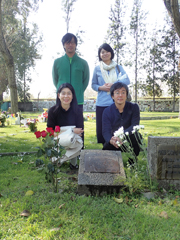
After completing the entire field study program, Dr. Maruyama (front row right) and other members gather at the grave of Dr. Shiraishi to pray for the success of the project.
Particularly significant was the participation of the Fisheries Development Institute (Instituto de Fomento Pesquero, IFOP), since IFOP's research has been based on the hypothesis that red tide comes from the south with the ocean current. The joint research partners hope that the monitoring data that IFOP has accumulated will be useful for the project.
There is another issue of concern in Chile: Some plankton can cause shellfish poisoning, a potential health hazard since a great number of Chilean people consume substantial amounts of shellfish. For that reason, Chile's Ministry of Health, which inspects 200 cases of harvested shellfish each day, joined the project. Thus, another goal of the red tide prediction system is to protect people's health.
Dr. Maruyama's motto is, "There is an important key hidden in any person's words." Following his motto, he always takes care to engage in dialogue with various stakeholders. The current survey involved interviews with local independent fishers. One of them stressed the importance of organizing frequent explanatory sessions through the local fish farmers' associations to help local independent fishermen understand the situation. The researchers decided to include such sessions in the project in the future.
In Santiago lies the tomb of Dr. Yoshikazu Shiraishi, a fisheries expert who contributed to research on salmon and trout in Chile. Clearly there is a strong, well-established mutual interest between Chile and Japan in terms of ocean work. These new cooperative efforts to protect the fisheries industry are an extension of that longstanding bond.




scroll